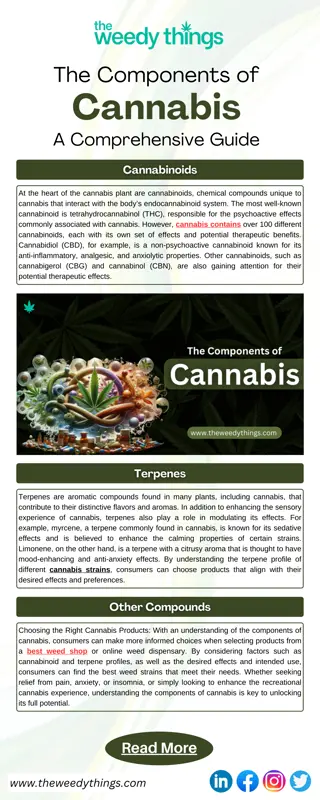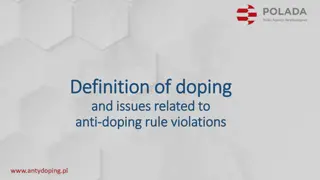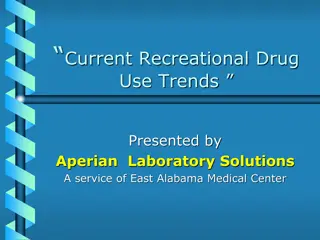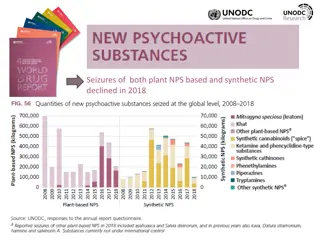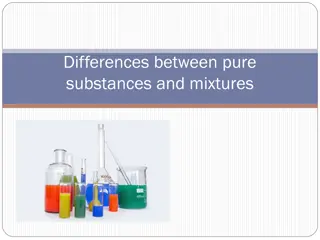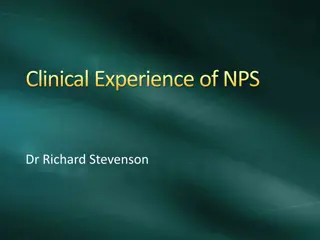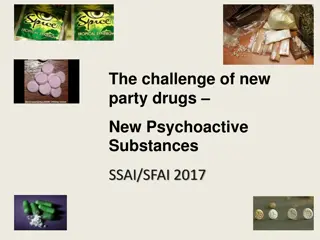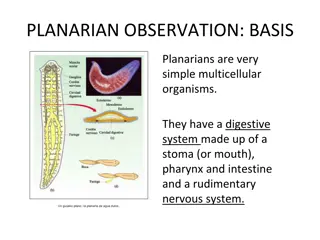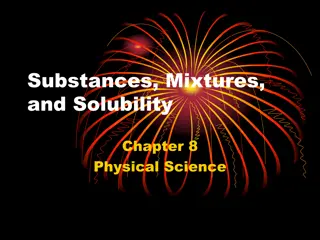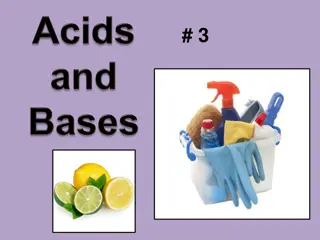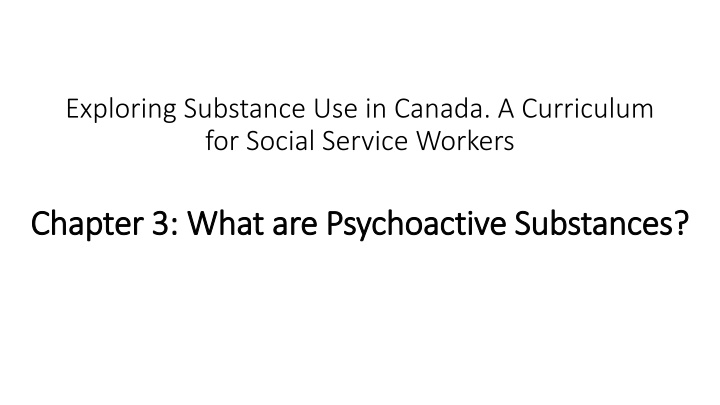
Understanding Psychoactive Substances and Opioids in Canada
Explore the classifications and effects of psychoactive substances, including depressants, stimulants, hallucinogens, and opioids. Learn about the various forms of opioids, their effects, and medical uses while discussing the risks associated with their misuse in Canada.
Download Presentation

Please find below an Image/Link to download the presentation.
The content on the website is provided AS IS for your information and personal use only. It may not be sold, licensed, or shared on other websites without obtaining consent from the author. If you encounter any issues during the download, it is possible that the publisher has removed the file from their server.
You are allowed to download the files provided on this website for personal or commercial use, subject to the condition that they are used lawfully. All files are the property of their respective owners.
The content on the website is provided AS IS for your information and personal use only. It may not be sold, licensed, or shared on other websites without obtaining consent from the author.
E N D
Presentation Transcript
Exploring Substance Use in Canada. A Curriculum for Social Service Workers Chapter 3: What are Psychoactive Substances? Chapter 3: What are Psychoactive Substances?
Identify substance classification groupings Define terminology related to substance Discuss substance interactions and multi- substance use Discuss the medical usefulness of psychoactive substances Learning Objectives:
Allow access for *lawful purposes; Reduce the risk that controlled substances and precursors will be used for illegal purposes (Government of Canada, 2021). Lawful purposes include using substances like aspirin or ibuprofen for aches and pains as well as any medication that may have been prescribed to you.) Government of Canada, 2021 Health Canada administers the CDSA and its regulations to: Government of Canada, 2021
Psychoactive Substances Psychoactive substances change the function of the brain and result in alterations of mood, thinking, perception, and/or behaviour. They may be used for many purposes, including therapeutic, ritual/cultural, or recreational purposes. Psychoactive substances come in many forms and are identified in many ways. Uppers, downers, X, bennies and oxy. Most commonly used psychoactive substances include: Depressants: Alcohol, Barbiturates (schedule 4), GHB/Rohypnol (schedule 4) Stimulants: Caffeine, Nicotine, Cocaine (schedule 1), Amphetamine (schedule 1), Ecstasy (schedule 3) Hallucinogens: Psylocibin mushrooms (schedule 3), Cannabis, LSD (schedule 3), Mescaline (schedule 3) Opiates: Morphine (schedule 1), Oxycodone (schedule 1), Fentanyl (schedule 1), Heroin (schedule 1), Carfentanil (schedule 1) Psychotherapeutic agents: Valium (schedule 4), Efexor (schedule 4), Anabolic steroids (schedule 4)
Opioids The poppy Papaver somniferum is the source of all-natural opioids, whereas synthetic opioids are made entirely in a lab and include meperidine, fentanyl, and methadone Semi-synthetic opioids are synthesized from naturally occurring opium products, such as morphine and codeine, and include heroin, oxycodone, hydrocodone, and hydromorphone. Opioids come in various forms including: Tablets, Capsules, Skin patches, Powder Chunks in varying colors (from white to shades of brown and black), Liquid form for oral use and injection, Syrups, Suppositories, Lollipops. Opioids can be swallowed, smoked, sniffed, injected or used transdermally. Opioids produce a general sense of well-being by reducing tension, anxiety, and aggression. Opioid use comes with a variety of unwanted effects, including drowsiness, inability to concentrate, and apathy. Opioids are prescribed to treat pain, suppress a cough, cure diarrhea, and put people to sleep. Effects depend heavily on the dose, how it is taken, and previous exposure to the substance. Negative effects include slowed physical activity, constriction of the pupils, flushing of the face and neck, constipation, nausea, vomiting, and slowed breathing. As the dose is increased, both the pain relief and the harmful effects become more pronounced. A single dose can be lethal to an inexperienced person or someone who has been in recovery. Physical dependence is a consequence of chronic opioid use, and withdrawal takes place when the use is discontinued. The intensity and character of the physical symptoms experienced during withdrawal are directly related to: The substance, The daily amount used, The interval between doses, The duration of use, -Health and personality of the person using the opiate. These symptoms usually appear shortly before the time of the next scheduled dose, increasing dependence. Early withdrawal symptoms often include: Watery eyes, Runny nose, Yawning, Sweating As the withdrawal worsens, symptoms can include: Restlessness, Irritability, Loss of appetite, Nausea, Tremors, Drug craving, Severe depression, Vomiting, Increased heart rate and blood pressure, Chills alternating with flushing and excessive sweating. Without intervention, the withdrawal usually runs its course, and most physical symptoms disappear within days or weeks, depending on the substance. Withdrawal is extremely uncomfortable and is one reason why people continue to use opioids. Relapse is common if there are no changes to the physical, biological, social, or other factors that contributed to the use/abuse of the opioid.
Prescription Heroin Offered in Vancouver Outside of Clinical Trial for 1st Time https://youtu.be/e9wqG-UkGFI (CBC News, 2014).
Fentanyl Heroin Is a potent synthetic opioid drug approved by the CDSA for use as an analgesic (pain relief) and as an anesthetic. Heroin is processed from morphine, a naturally occurring substance extracted from the seed pod of certain varieties of poppy plants grown in Mexico, South America, Southwest Asia (Afghanistan and Pakistan), and Southeast Asia (Thailand, Laos, and Myanmar (Burma). It is approximately 100 times more potent than morphine and 50 times more potent than heroin as an analgesic. Fentanyl was first developed in 1959 and introduced in the 1960s as an intravenous anesthetic. Heroin is typically sold as a white or brownish powder, or as the black sticky substance known as black tar heroin. Although purer heroin is becoming more common, most regular heroin is cut with other psychoactive substances or substances like sugar, starch, powdered milk, or quinine. It is legally manufactured in the United States. Fentanyl products are prescribed and are currently available orally, transdermally and injectable formulations. Heroin can be injected, smoked, or sniffed/snorted. High purity heroin is usually snorted or smoked. Fentanyl can be injected, snorted/sniffed, smoked, taken orally by pill or tablet, and spiked onto blotter paper. One of the most significant effects of heroin use is the frequency of the development of a substance use disorder. Fentanyl patches can be used other than prescribed by removing its gel contents and then injecting or ingesting these contents. Patches have also been frozen, cut into pieces, and placed under the tongue or in the cheek cavity. With regular heroin use, tolerance to the substance develops. The person must use more heroin to achieve the same intensity. As higher doses of the substance are used over time, physical dependence and psychological dependence deepens and a substance use disorder can develop. Fentanyl, similar to other commonly used opioid analgesics(e.g., morphine), produces effects such as relaxation, euphoria, pain relief, sedation, confusion, drowsiness, dizziness, nausea, vomiting, urinary retention, pupillary constriction, and respiratory depression. Effects of heroin use include drowsiness, respiratory depression, constricted pupils, nausea, a warm flushing of the skin, dry mouth, and heavy extremities.
Vending Machine Dispenses Heroin Substitute For At-Risk Users https://youtu.be/OTx_Z58ZGwY (The Canadian Press, 2020).
Hydromorphone Methadone Hydromorphone has an analgesic potency of two to eight times greater than that of morphine and has a rapid onset of action. Methadone is a synthetic (person-made) drug. It is considered an opioid agonist therapy (OAT); used to treat opioid addiction. Hydromorphone is legally manufactured and distributed in the United States and shipped to Canada. It is also used to treat severe pain. German scientists synthesized methadone during World War II because of a shortage of morphine. Methadone was introduced to Canada in 1964 (Eibl, 2017). Hydromorphone comes in tablets, capsules, oral solutions, and injectable formulations. Hydromorphone may cause constipation, pupillary constriction, urinary retention, nausea, vomiting, respiratory depression, dizziness, impaired coordination, loss of appetite, rash, slow or rapid heartbeat, and changes in blood pressure. Methadone is available as a tablet, oral solution, or injectable liquid. When an individual uses methadone, they may experience physical symptoms like sweating, itchy skin, or sleepiness. There is a risk for developing tolerance and subsequent dependence on the methadone. When use is stopped, individuals may experience withdrawal symptoms similar to other opioids including: Anxiety, muscle tremors, nausea, diarrhea, vomiting, and abdominal cramps. A person can overdose on methadone, in which case Naloxone may be used to treat the overdose. Learn more about methadone in this short clip below. This Photo by Unknown Author is licensed under CC BY-SA-NC
Morphine Oxycodone Morphine is a non-synthetic opioid. Oxycodone is a semi-synthetic opioid used to treat pain. It is derived from opium and is considered an analgesic. Oxycodone was developed in 1995, beginning as OxyContin. It is used for the treatment of pain and is the most widely used pain treatment medication in the world (Hamilton & Basekett, 2000). It was created to provide long-lasting pain relief and was widely prescribed. It was hailed as a miracle drug for long lasting pain; however, those who had been prescribed oxy found it had highly addictive qualities (Centre for Addiction and Mental Health, 2021). Morphine was isolated from opium by Friedrich Serturner in 1805. Oxycodone is synthesized from thebaine, a constituent of the poppy plant. Morphine is made from opium, which has been known for millennia to relieve pain. Oxycodone is administered orally or intravenously. The tablets can be crushed and sniffed or dissolved in water and injected. It can also be inhaled. The Sumerian clay tablet (about 2100 BC) is considered the world s oldest recorded list of medical prescriptions (Norn et al, 2005) and includes morphine. It was not until the development of the hypodermic needle and syringe nearly 50 years later that the use of morphine became widespread using morphine for postoperative pain relief (Hamilton & Baskett, 2000). Physiological effects of oxycodone include pain relief, sedation, respiratory depression, constipation, papillary constriction, and cough suppression. Traditionally, morphine was almost exclusively used by injection, today it can be taken by all routes of administration. This includes oral solutions, immediate-and extended-release tablets and capsules, subcutaneous, transdermal and intramuscular. Extended or chronic use of oxycodone containing acetaminophen may cause severe liver damage. Morphine use results in relief from physical pain, a decrease in hunger, and inhibition of the cough reflex.
2 Minute Neuroscience: Methadone https://youtu.be/dw6laQ4-Zgs (Neuroscientifically Challenged, 2019).
Opioid Overdose Overdoses are common and can be fatal with opiate use. Physical signs of opioid overdose include: Constricted (pinpoint) pupils Cold clammy skin, confusion Convulsions Extreme drowsiness Slowed breathing Opioid overdose is a crisis in Canada and tens of thousands of lives have been needlessly lost; between 2016 and September 2021 over 22,000 people died, that is twenty people per day who lost their lives to an opiate overdose (Government of Canada, 2021). This Photo by Unknown Author is licensed under CC BY-SA
Alarming Overdose Facts and Statistics: People who are homeless are at higher risk of death from overdose (Bauer et al, 2016). Indigenous people are significantly over- represented in the loss of lives by overdose in Canada. Recent data from Alberta and British Columbia, the provinces most heavily impacted by the crisis, indicates that First Nations people are five times more likely to experience an overdose and three times more likely to die from overdose than non- First Nations people (Jongblood et al., 2017). While men aged 30 to 39 make up the biggest group of deaths across the country, women are dying at a similar rate in the Prairies and eastern provinces (CATIE, 2020). (Government of Canada, 2021).
Overdose Prevention: Naloxone Overdose Prevention: Naloxone Naloxone is used to treat an opioid overdose, it is a temporary opiate antagonist (a substance which blocks or reverses the effects of opioids, including extreme drowsiness, slowed breathing, or loss of consciousness). Naloxone only works for opioids. This temporarily reverses an overdose; however medical intervention is still required. Naloxone is NOT permanent. NS health recommends that if a person who has overdosed is not taken to a hospital, the overdose victim can fall back into the overdose within 30 minutes; therefore, Naloxone should not be considered as step 1, in a multi-step process for addressing an opiate overdose. As you are learning, opiates are having an impact on all communities in Canada. As Social Service workers, you may consider accessing a naloxone kit. You can save a life. This Photo by Unknown Author is licensed under CC BY-SA
Who is Your Kit For? https://vimeo.com/300496867 (Nova Scotia Health, 2018a).
Stimulants Chronic, high-dose use is frequently associated with agitation, hostility, panic, aggression, and suicidal or homicidal tendencies. This class of drugs includes methamphetamine, cocaine and prescription drugs such as amphetamines [Adderall and Dexedrine], and Methylphenidate [Concerta and Ritalin]. Paranoia, sometimes accompanied by both auditory and visual hallucinations, may also occur. Stimulants speed up the body s systems. Stimulants have a long and varied use throughout the world. For example, the leaves of the coca plant were chewed and aoca chewing has a long history of Indigenous use in South American countries (Thoumi, 2003). Tolerance, in which more and more of the substance is needed to produce the usual effects, can develop rapidly, and psychological dependence occurs. When cocaine was isolated from coca in 1859, widespread use became the norm in Canada; a medical publication in 1884 was even created to promote its benefits (Ciccarone, 2011). The strongest psychological dependence observed occurs with the more potent stimulants, such as amphetamine, methylphenidate, methamphetamine, cocaine, and methcathinone. Stimulants come in the form of pills, powder, rocks, and injectable liquids. Abrupt cessation is commonly followed by a crash (depression, anxiety, craving, and extreme fatigue). Stimulants can be pills or capsules that are swallowed . Smoking, snorting, or injecting stimulants produces a sudden sensation known as a rush or a flash. Stimulants are sometimes referred to as uppers and reverse the effects of fatigue on both mental and physical tasks. Substance use disorders reflect a pattern of binge use (sporadically consuming large doses of stimulants over a short period of time). Therapeutic levels of stimulants can produce exhilaration, extended wakefulness, and loss of appetite. These effects are greatly intensified when large doses of stimulants are taken. Heavy use may include injecting every few hours, continuing until the supply is gone or a point of delirium, psychosis, and physical exhaustion is reached. Taking too large a dose at one time or taking large doses over an extended period of time may cause such physical side effects as dizziness, tremors, headache, flushed skin, chest pain with palpitations, excessive sweating, vomiting, and abdominal cramps. During heavy use, all other interests often become secondary to recreating the initial euphoric rush. When used as part of a substance use disorder, stimulants are frequently taken to get high (produce a sense of exhilaration, enhance self-esteem, improve mental and physical performance, increase activity, reduce appetite, or extend wakefulness for a prolonged period). Stimulants are controlled under the CDSA as a Schedule I substance. Some prescription stimulants are not controlled (for example ephedrine can be found in some allergy and cold medicine) and some stimulants like tobacco and caffeine do not require a prescription.
Amphetamines The effects of amphetamines and methamphetamine are similar to cocaine, but their onset is slower and their duration is longer. In contrast to cocaine, which is quickly removed from the brain and is almost completely metabolized, methamphetamine remains in the central nervous system longer, and a larger percentage of the drug remains unchanged in the body, producing prolonged stimulant effects. Amphetamines are stimulants that speed up the body s system. Many are legally prescribed and used to treat attention-deficit hyperactivity disorder (ADHD) Stimulants like amphetamine were developed as pharmaceutical drugs in the late 1920s, treating ashtma and other bronchial ailments. Chronic use produces a psychosis that resembles schizophrenia and is characterized by paranoia, picking at the skin, preoccupation with one s own thoughts, and auditory and visual hallucinations. Amphetamine was first marketed in the 1930s as Benzedrine in an over-the-counter inhaler to treat nasal congestion. By 1937 amphetamine was available by prescription in tablet form and was used in the treatment of the sleeping disorder narcolepsy and ADHD. Violent and erratic behavior is frequently seen among people use have an amphetamine or methamphetamine use disorder. Pharmacological effects on attention and cognition, emotions, and appetite were explored thoroughly in the 1930s and 1940s (Rasmussen, 2015). Physical effects of amphetamine use include increased blood pressure and pulse rates, insomnia, loss of appetite, and physical exhaustion. Amphetamines began to be controlled by the Narcotic Control Act in 1961 which is now Canada s Controlled Drug and Substances Act. Amphetamines are Schedule I stimulants and are available only through a prescription. Amphetamines can look like pills or powder. Amphetamines are generally taken orally or injected. Ice, (the slang name of crystallized methamphetamine hydrochloride) has promoted smoking as another mode of administration.
Methamphetamine Methamphetamine (meth) is a stimulant Long-term meth use results in many damaging effects, including the development of a substance use disorder. Methamphetamine (meth) is a derivative of amphetamine and was synthesized in Japan in 1919. According to Parsons (2013), methamphetamine was used to treat a number of chronic illnesses, including asthma, schizophrenia, depression, Parkinson s disease, and narcolepsy. Researchers have reported that as much as 50 percent of the dopamine-producing cells in the brain can be damaged after prolonged exposure to relatively low levels of meth. Researchers also have found that serotonin-containing nerve cells may be damaged even more extensively. Methamphetamine use can result in increased wakefulness, increased physical activity, decreased appetite, rapid breathing and heart rate, irregular heartbeat, increased blood pressure, and hyperthermia (overheating). Meth is swallowed, snorted, injected, or smoked. Regular meth is a pill or powder. High doses can elevate body temperature to dangerous, sometimes lethal, levels, and cause convulsions and even cardiovascular collapse and death. Methamphetamine also comes in crystal forms (crystal meth), which resembles glass fragments or shiny blue-white rocks of various sizes. Meth use may also cause extreme anorexia, memory loss, and severe dental problems. Meth is a potent substance with central nervous system (CNS) stimulant properties. High usage may result in death from stroke, heart attack, or multiple organ problems caused by overheating. People who smoke or inject it report a brief, intense sensation, or rush. Methamphetamine is a Schedule I stimulant under the CDSA. Oral ingestion or snorting produces a long-lasting high instead of a rush, which reportedly can continue for as long as half a day. Both the rush and the high are believed to result from the release of very high levels of the neurotransmitter dopamine into areas of the brain that regulate feelings of pleasure.
Cocaine Following smoking or intravenous injection, cocaine reaches the brain in seconds, with a rapid buildup in levels (check section 3.1 for routes of administration). This results in a rush (a rapid- onset, intense euphoric effect). By contrast, the euphoria caused by snorting cocaine is less intense and does not happen as quickly due to the slower build-up of the substance in the brain. Cocaine is an intense, euphoria-producing stimulant. Cocaine is derived from coca leaves grown in some countries in South America. Acording to the UNODC (2010) from the end of World War II until the late 1990s, almost all the world s coca bush was grown in Peru and the Plurinational State of Bolivia, and since the 1970s, most of this output was refined into cocaine in Colombia. Other effects include increased alertness and excitation, as well as restlessness, irritability, and anxiety. Tolerance to cocaine s effects develops rapidly, causing people to take higher and higher doses. The cocaine manufacturing process takes place in remote labs where the raw product undergoes a series of chemical transformations. Colombia now produces about 50% of the cocaine powder reaching North America. Taking high doses of cocaine or prolonged use can cause paranoia. The crash that follows euphoria is characterized by mental and physical exhaustion, sleep, and depression lasting several days. Following the crash, people often experience a craving to use cocaine again. Cocaine is usually distributed as a white, crystalline powder, it is often diluted ( cut ) with a variety of substances. In contrast, cocaine base (crack) looks like small, irregularly shaped chunks (or rocks ) of a whitish solid. Physiological effects of cocaine use include increased blood pressure and heart rate, dilated pupils, insomnia, and loss of appetite. Powdered cocaine can be snorted or injected into the veins after dissolving in water. The use of highly pure cocaine has led to many severe adverse health consequences such as cardiac arrhythmias, ischemic heart conditions, sudden cardiac arrest, convulsions, strokes, and death. Cocaine base (crack) is smoked. The long-term use of inhaled cocaine has led to a unique respiratory syndrome, and chronic snorting of cocaine has led to the erosion of the upper nasal cavity. Cocaine is also used in speedballing (a practice where the cocaine is combined with opioids, like heroin). Although injecting, snorting, and smoking are the common ways of using cocaine, all mucous membranes readily absorb cocaine. Cocaine is a Schedule I drug under the CDSA. The intensity of cocaine s euphoric effects depends on how quickly the drug reaches the brain, which depends on the amount and method of use.
Khat Khat is a flowering evergreen shrub that is used for its stimulant-like effect. Khat has two active ingredients, cathine, and cathinone. Khat is native to countries in Eastern Africa including Ethiopia and the Arabian Peninsula, where the use of it is an established cultural tradition for many social situations. Cultures in East Africa and the Arabian Peninsular have used khat as a stimulant since the seventh century and the practice of coming together to chew the leaves of the khat plant has acquired unique cultural importance (Stevenson et al, 1996, p.73). Khat use is prevalent in Ethiopia in particular amongst the Oromo people; it is used not only at weddings, births, funerals and other celebratory events, but can be used daily as part of barcha or the afternoon chew (Gebissa, 2012). This Photo by Unknown Author is licensed under CC BY-SA Khat is a flowering evergreen shrub, the leaves of the shrub are used. Khat causes an increase in blood pressure and heart rate. Khat is typically chewed like tobacco, then retained in the cheek and chewed intermittently to release the active drug, which produces a stimulant-like effect. Dried Khat leaves can be made into a tea or a chewable paste, and Khat can also be smoked and even sprinkled on food. Khat can also cause a brown staining of the teeth, insomnia, and gastric disorders. The amount needed to constitute an overdose is not known. Symptoms of toxicity include delusions, loss of appetite, difficulty with breathing, and increases in both blood pressure and heart rate. Khat can induce a stimulant-like alertness but has a very low potency. According to Mitchell (2001) the ephedrine-like effects in khat are closer to cigarettes than a cup of coffee. It s more like a nicotine patch. Khat is a Schedule IV substance under the CDSA.
Tobacco Nicotine activates the brain s reward circuits and increases levels of the chemical messenger dopamine, which reinforces rewarding behaviors. Tobacco is a plant grown for its leaves, which are dried and fermented before being put in tobacco products. Tobacco contains nicotine. Studies suggest that chemicals in tobacco smoke, such as acetaldehyde, may enhance nicotine s effects on the brain. Tobacco was grown in countries in South America and North America and has been used by Indigenous communities as a cultural and traditional herb. Prolonged use can lead to lung cancer, chronic bronchitis, and emphysema. It increases the risk of heart disease, which can lead to stroke or heart attack. Tobacco used in ritual, ceremony, and prayer, tobacco was considered a sacred plant with immense healing and spiritual benefits and was used by Indigenous cultures across Canada (First Nations Health Authority, 2021, para. 1). Nontraditional use of tobacco has also been linked to other cancers, leukemia, cataracts, and pneumonia. Chew increases the risk of cancer, especially mouth cancers. People can smoke, chew, or sniff tobacco. Nontraditional tobacco smoking can impact women who are pregnant and the fetus. Smoked tobacco products include cigarettes, cigars, bidis, and kreteks. People who are exposed to secondhand smoke are at a higher risk of lung cancer and heart disease. Some people smoke loose tobacco in a pipe or hookah (water pipe). It can cause health problems in both adults and children, such as coughing, phlegm, reduced lung function, pneumonia, and bronchitis. Chewed tobacco products include chew (chewing tobacco), snuff, dip, and snus; snuff can also be sniffed. Children exposed to secondhand smoke are at an increased risk of ear infections, severe asthma, lung infections, and death from sudden infant death syndrome. The nicotine in any tobacco product readily absorbs into the blood when a person uses it. Upon entering the blood, nicotine immediately stimulates the adrenal glands to release the hormone epinephrine (adrenaline). Epinephrine stimulates the central nervous system and increases blood pressure, breathing, and heart rate. The 2018 Tobacco and Vaping Products Act regulates the manufacture; sale; packaging and labeling; and advertising, promotion and sponsorship of tobacco and vaping products (Government of Canada, 2021).
Traditional Tobacco Use https://youtu.be/PXFPBD6k73I (AHS Channel, 2016).
E-cigarettes: Welcome Back, Big Tobacco https://youtu.be/B2myg-4zkE8 (The Fifth Estate, 2016).
Depressants They can cause amnesia, leaving no memory of events that occur while under the influence of the substance, reduce reaction time, impair mental functioning and judgment, and cause confusion. Depressants will put you to sleep, relieve anxiety and muscle spasms, and prevent seizures. Barbiturates, an older type of depressant, include Phenobarbital, Pentothal, Seconal, and Nembutal. Long-term use of depressants produces psychological dependence and tolerance. Benzodiazepines, a newer type of depressant, were developed to replace barbiturates. Some examples are Valium, Xanax, Halcion, and Ativan. Some depressants can relax the muscles. Other depressants inlcude Lunesta, Ambien, and Sonata, sedative medications approved for the short-term treatment of insomnia that share many of the properties of benzodiazepines. Other physical effects include slurred speech, loss of motor coordination, weakness, headache, light- headedness, blurred vision, dizziness, nausea, vomiting, low blood pressure, and slowed breathing. Other depressants include Quaalude, GHB and Rohypnol, and alcohol. Prolonged use of depressants can lead to physical dependence even at doses recommended for medical treatment. Alcohol has a long history, back many thousands of years, some pharmaceutical depressants were identified in the 1950 s. Unlike barbiturates, large doses of benzodiazepines are rarely fatal unless combined with other drugs or alcohol. Depressants come in the form of pills, syrups, and injectable liquids. Withdrawal from depressants can be life-threatening. Individuals may use oral administration, injection, or snorting to take depressants. Most depressants are controlled substances that range from Schedule I to Schedule IV under the CDSA. Depressants induce sleep, relieve anxiety and muscle spasms, and prevent seizures.
Alcohol Barbiturates Alcohol is a widely available depressant in Canada and alcohol use in Canada is significant. According to the Canadian Centre on Substance Use and Addiction (2017) alcohol is the most commonly used substance by Canadians. Barbiturates are depressants that produce a wide spectrum of central nervous system depression from mild sedation to coma. They have been used as sedatives, hypnotics, anesthetics, and anticonvulsants. For most of the past 10,000 years, alcoholic beverages were the most popular and common daily drink among people in Western civilization (Stewart, 2004, para. 1). Alcohol is produced by fermenting or distilling various fruits, vegetables or grains. The clinical introduction of barbiturates begun in when the Farbwerke Fr. Bayer and Co. brought onto the market the first agent of this type, diethyl- barbituric acid, giving rise to profound changes in the pharmacological approach to the psychiatric and neurological disorders of the time (L pez- Mu oz et al., 2005, p. 329). Fermented beverages include beer and wine and have a maximum alcohol content of about 15%. Liquor (distilled beverages such as rum, whisky and vodka) have a higher alcohol content (Centre for Addiction and Mental Health, 2021a). Alcohol is a liquid substance; ethyl (pure) alcohol is a clear, colourless liquid (Centre for Addiction and Mental Health, 2021a). Barbiturates come in a variety of multi-colored pills and tablets as well as in liquid form. You will find alcohol in beer, wine, spirits, rubbing alcohol, hand sanitizer, cough syrup, perfume, various extracts (like vanilla for baking), aftershave, mouthwash and some body washes. Barbiturates are most often consumed orally or by injecting a liquid. Barbiturates are generally administered to reduce anxiety and decrease inhibitions. Alcohol is consumed orally. Alcohol is a depressant that suppresses central nervous system activity (CNS). Barbiturates can be extremely dangerous because overdoses can occur easily and lead to death. At rather low doses, alcohol use is associated with feelings of euphoria. As the dose increases, people report feeling sedated. With excessive alcohol use, a person might experience a complete loss of consciousness and/or difficulty remembering events that occurred during a period of intoxication (McKim & Hancock, 2013). Barbiturates cause mild euphoria, lack of inhibition, relief of anxiety, and sleepiness. Psychological dependence is high with alcohol, due to the impact on the CNS. Higher doses cause impairment of memory, judgment, and coordination; irritability; and paranoid and suicidal ideation. Generally, alcohol is associated with decreases in reaction time and visual acuity, lowered levels of alertness, and reduction in behavioral control. Tolerance develops quickly and larger doses are then needed to produce the same effect, increasing the danger of an overdose. Alcohol can cause birth defects such as Fetal Alcohol Spectrum Disorder (FASD) for women who are pregnant. Physical dependence of alcohol is high, as tolerance increases with the amount and frequency the alcohol is consumed. For people who have an alcohol use disorder, withdrawal can be life-threatening and should only be done under medical supervision. Barbiturates slow down the central nervous system and cause sleepiness. Overdose can occur easily. Barbiturates are Schedule IV depressants under the CDSA. Alcohol is legal in Canada and can be consumed by individuals ages 18 and over, depending on province. Provinces set their age limit for consumption as well as licensing for sale of alcohol.
Benzodiazepines GHB Benzodiazepines are depressants that produce sedation and hypnosis, relieve anxiety and muscle spasms, and reduce seizures. Gamma-Hydroxybutyric acid (GHB) is another name for the generic drug sodium oxybate. It is a substance naturally present in your body. GHB is often called a date-rape drug, because its sedative effects prevent victims from resisting sexual assault. They are used to induce sedation for surgery and other medical procedures, and in the treatment of seizures and alcohol withdrawal. GHB comes in liquid and powder form. Benzodiazepines are also called minor tranquillizers, sedatives or hypnotics. GHB was first synthesized in 1960 as an alternative anesthetic to aid in surgery because of its ability to induce sleep and reversible coma (O Connell et al, 2000, para. 16). The most common benzodiazepines are the prescription drugs Valium, Xanax, Halcion, Ativan, and Klonopin. In Canada, doctors can prescribe GHB for narcolepsy (a serious sleep disorder) and it is taken orally. Tolerance can develop, although at variable rates and to different degrees. GHB occurs naturally in the central nervous system in very small amounts. It acts as a depressant, slowing and calming the activity of the Central Nervous System (CNS). Effects including euphoria, drowsiness, decreased anxiety, confusion, and memory impairment. Shorter-acting benzodiazepines used to manage insomnia include Halcion and Versed, used for sedation, anxiety, and amnesia in critical care settings and prior to anesthesia. Benzodiazepines with a longer duration of action are utilized to treat insomnia in patients with daytime anxiety. These benzodiazepines include Xanax, Librium, Valium, Ativan and. Clonazepam. GHB can produce both visual hallucinations and paradoxically excited and aggressive behavior. Clonazepam is also used as an anticonvulsant. They are the most widely prescribed psychoactive drugs in the world (Centre for Addiction and Mental Health, 2021b). GHB greatly increases the CNS depressant effects of alcohol and other depressants, which increases the risk of overdose. In 1955, Hoffmann-La Roche chemist Leo Sternbach identified the first benzodiazepine, chlordiazepoxide (Librium) (Wick, 2013). Benzodiazepines are only available through prescription. GHB takes effect in 15 to 30 minutes, and the effects last 3 to 6 hours. Low doses of GHB produce nausea. Benzodiazepines come in both pill and liquid form. At high doses, GHB overdose can result in unconsciousness, seizures, slowed heart rate, greatly slowed breathing, lower body temperature, vomiting, nausea, coma, and death. Regular use of GHB can lead to tolerance and withdrawal that includes insomnia, anxiety, tremors, increased heart rate and blood pressure, and occasional psychotic thoughts. Benzodiazepines are taken orally or crushed to snort. They can also be injected. Benzodiazepines are associated with amnesia, hostility, irritability, and vivid or disturbing dreams. Effective antidotes to reverse the sedative and intoxicating effects of GHB do not exist (Busard & Jones, 2015, para. 1). Benzodiazepines slow down the central nervous system and may cause sleepiness. Death by overdose is possible. GHB can cause nausea, vomiting, incontinence, loss of consciousness, seizures, liver damage, kidney failure, respiratory depression, and death. GHB overdose can cause death. Benzodiazepines are controlled in Schedule IV of the CDSA. GHB is a Schedule IV controlled substance by the CDSA.
Hallucinogens Hallucinogens are found in plants and fungi or are synthetically produced and are among the oldest known group of drugs used for their ability to alter human perception and mood. Hallucinogens can be found in plants and their origin predates history. They are said to have been inhaled, ingested, worshipped, and reviled, used by early cultures in both sociocultural and ritual contexts (Abraham et al., 1996 & Nichols, 2004). They can also be made in laboratories. 5 different colored MDMA/Ecstacy tablets. There is a blue one with DEA imprinted on it, a pink one with SEX imprinted on it, a cream colored one with WB imprinted on it in the style of the Warner Brothers logo, an orange triangular one, and a green one with an X imprinted on it. MDMA/Ecstasy pills LSD Blotter Sheet Hallucinogens come in a variety of forms. MDMA or ecstasy tablets are sold in many colors with a variety of logos. LSD is sold in the form of impregnated paper (blotter acid), typically imprinted with colorful graphic designs. Cannabis is sold as a dried plant or oil and psyilobiclin is a dried mushroom. PCP and ketamine come in powder or pill form. The most commonly used hallucinogens are taken orally or smoked. Sensory effects include perceptual distortions that vary with dose, setting, and mood. Psychic effects include distortions of thought associated with time and space. Time may appear to stand still, and forms and colors seem to change and take on new significance. Some individuals may experience flashbacks (fragmentary recurrences of certain aspects of the experience) without having used the substance in weeks or even months. Physiological effects include elevated heart rate, increased blood pressure, and dilated pupils. Deaths exclusively from an acute overdose of LSD, magic mushrooms, and mescaline are extremely rare. Deaths generally occur due to suicide, accidents, and dangerous behavior, or due to the person inadvertently eating poisonous plant material. A severe overdose of PCP and ketamine can result in respiratory depression, coma, convulsions, seizures, and death due to respiratory arrest. Many hallucinogens are Schedule III under the CDSA
Cannabis According to the Canadian Tobacco, Alcohol and Drugs Survey in 2015, 3.6 million (or 12%) of Canadians used cannabis (Government of Canada, 2015). Since becoming legal in 2019, that number may be different due to confidence in self reporting. Humans have utilized cannabis products in various forms throughout recorded history. (Russo, 2017, p.1614). Cannabis is a hallucinogen, produced by the cannabis sativa plant. Cannabis contains More than 100 chemicals, called cannabinoids that have been identified as specific to the cannabis plant. THC (delta-9-tetrahydrocannabinol) is the main psychoactive cannabinoid and is most responsible for the high associated with cannabis use. When marijuana is smoked, the THC passes from the lungs and into the bloodstream, which carries the chemical to the organs throughout the body, including the brain. In the brain, the THC connects to specific sites called cannabinoid receptors on nerve cells and influences the activity of those cells. Many of these receptors are found in the parts of the brain that influence pleasure, memory, thought, concentration, sensory and time perception, and coordinated movement. Another cannabinoid is cannabidiol (CBD), which has little or no psychoactive effects, so you do not feel high. CBD counteracts some of the negative effects of THC (CAMH, 2021). The short-term effects of marijuana include feelings of euphoria, anxiousness, even fear, depending on the person. Others have indicated feelings of distorted perception, difficulty in thinking and problem-solving, and loss of coordination. Hashish and hashish oil are substances made from the cannabis plant that is like marijuana, only stronger. It consists of the THC-rich resinous material of the cannabis plant, which is collected, dried, and then compressed into a variety of forms, such as balls, cakes, or cookie-like sheets. Pieces are then broken off, placed in pipes or mixed with tobacco and placed in pipes or cigarettes, and smoked. Hashish oil is produced by extracting the cannabinoids from the plant material with a solvent. The color and odor of the extract will vary, depending on the solvent used. The effect of marijuana on perception and coordination are responsible for serious impairments in learning, associative processes, and psychomotor behavior (for example driving abilities). Long-term, regular use can lead to physical dependence and withdrawal following discontinuation, as well as psychological dependence. Short-term physical effects from marijuana use may include sedation, bloodshot eyes, increased heart rate, coughing from lung irritation, increased appetite, and decreased blood pressure. Cannabis is currently grown all over the world and it can be cultivated in both outdoor and indoor settings. Marijuana is a dry, shredded green/brown mix of flowers, stems, seeds, and leaves from the Cannabis sativa plant. The mixture typically is green, brown, or gray in color and may resemble tobacco. It has a strong smell. Withdrawal symptoms also include behavioral signs such as restlessness, irritability, sleep difficulties, and decreased appetite. No deaths from overdose of marijuana have been reported. On October 17, 2018, the Cannabis Act came into force. Adults who are 18 or 19 years or older (depending on province or territory) are able to possess up to 30 grams of legal dried cannabis, or its equivalent in non-dried form, in public, share up to 30 grams of dried cannabis or its equivalent with other adults, buy cannabis products from a provincial or territorial retailer, grow up to 4 plants per residence (not per person) for personal use: from legally acquired seeds or seedlings depending on the province or territory (Government of Canada, 2021). Marijuana is usually smoked as a cigarette (a joint) or in a pipe or bong. It is also smoked in blunts, which are cigars that have been emptied of tobacco and refilled with marijuana, sometimes in combination with another drug. Marijuana is also mixed with foods or brewed as a tea (ganja tea, used in Jamaica) (Russo, 2017). It is also sold in edible form, in products from candy to salad oils to baked goods.
New Cannabis Products: What Canadians Need To Know (Healthy Canadians, 2019).
Ecstasy/ MDMA LSD LSD is a hallucinogen that has no accepted medical use in treatment in Canada. MDMA acts as both a stimulant and psychedelic, producing an energizing effect, distortions in time and perception, and enhanced enjoyment of tactile experiences. People use it to reduce inhibitions and to promote euphoria, feelings of closeness, empathy, and sexuality. LSD was synthesized in 1943 by Albert Hofmann at Sandoz Pharmaceutical Laboratories in Switzerland (Dyck, 2015). It was used over the next fifteen years in a variety of applications from treating other substance use disorders like alcohol as well as mental health disorders like schizophrenia (2015). The substance fell from favor as a method of treatment for any disorder and was added to the CDSA. Although MDMA is known among users as ecstasy, researchers have determined that many ecstasy tablets contain not only MDMA but also a number of other drugs or drug combinations that can be harmful, including fentanyl. LSD comes in tablets, capsules, and occasionally in liquid form. It is an odorless and colorless substance with a slightly bitter taste. LSD is often added to absorbent paper, such as blotter paper, and divided into small decorated squares, with each square representing one dose. German company Merck mentioned MDMA for the first time in files from 1912 (Bernschneider et al., 2006, p.966). MDMA was tested by Merck as a blood-clotting medicine in the 1960 s; not as an appetite suppressant as has been debunked by both scholars and Merck. LSD is generally taken orally. In 1960, the first official recipe for ecstasy appeared in a scientific journal and by 1970 MDMA was being used in North America (Freudenmann et al., 2006). During the first hour after ingestion, users may experience visual changes with extreme changes in mood. While hallucinating, the user may suffer impaired depth and time perception accompanied by a distorted perception of the shape and size of objects, movements, colors, sound, touch, and the user s own body image. The ability to make sound judgments and see common dangers is impaired, making the user susceptible to personal injury. It is possible for users to suffer acute anxiety and depression after an LSD trip and flashbacks have been reported days, and even months, after taking the last dose. MDMA is mainly distributed in tablet form; MDMA tablets are sold with logos, creating brand names for people to seek out. MDMA is also distributed in capsules, powder, and liquid forms. Use mainly involves swallowing tablets, which are sometimes crushed and snorted, occasionally smoked but rarely injected. MDMA is also available as a powder. The physical effects include dilated pupils, higher body temperature, increased heart rate and blood pressure, sweating, loss of appetite, sleeplessness, dry mouth, and tremors. MDMA mainly affects brain cells that use the chemical serotonin to communicate with each other. Serotonin helps to regulate mood, aggression, sexual activity, sleep, and sensitivity to pain. Clinical studies suggest that MDMA may increase the risk of long-term problems with memory and learning. MDMA causes changes in perception, including euphoria and increased sensitivity to touch, energy, sensual and sexual arousal, need to be touched, and need for stimulation. LSD is a Schedule III substance under the CDSA. Some unwanted psychological effects include: Confusion, anxiety, depression, paranoia, sleep problems, and drug craving. All these effects usually occur within 30 to 45 minutes of swallowing the drug and usually last 4 to 6 hours, but they may occur or last weeks after ingestion. People who take MDMA may experience some of the same effects as those who use stimulants such as cocaine and amphetamines. These include increased motor activity, alertness, heart rate, and blood pressure. In high doses, MDMA can interfere with the body s ability to regulate temperature. This can lead to a sharp increase in body temperature (hyperthermia), resulting in liver, kidney, and cardiovascular system failure, and death. Because MDMA can interfere with its own metabolism (its breakdown within the body), potentially harmful levels can be reached by repeated drug use within short intervals. Studies suggest the chronic use of MDMA can produce damage to the serotonin system. MDMA is a Schedule III drug under the Controlled Substances Act.
Peyote Psilocybin Peyote is a small, spineless cactus. The active ingredient in peyote is the hallucinogen mescaline. Psilocybin is a chemical obtained from certain types of fresh or dried mushrooms. Peyote has been used by Indigenous peoples in North and South America as a part of their religious rites for thousands of years. A recent study has shown prehistoric use of peyote by native North Americans and a radiocarbon study dated the dried cacti to the time interval 3780 3660 BCE (Beyer, 2013). Mescaline can be extracted from peyote or produced synthetically. Psilocybin mushrooms are found in Southern and Northern American countries. Evidence from antiquity suggests psilocybin mushrooms were used by different, geographically separated ancient cultures (Akers et al, 1992), with the most prominent evidence from ancient meso-American cultures, who described psilocybin mushrooms as teonanacatl ( flesh of god ) (Rucker & Young, 2021). The top of the peyote cactus is referred to as the crown and consists of disc-shaped buttons that are cut off. These buttons are called mescal buttons. Mushrooms containing psilocybin are available fresh or dried and have long, slender stems topped by caps with dark gills on the underside. Fresh mushrooms have white or whitish-gray stems; the caps are dark brown around the edges and light brown or white in the center. Dried mushrooms are usually rusty brown with isolated areas of off-white. The fresh or dried buttons are chewed or soaked in water to produce a liquid. Peyote buttons may also be ground into a powder that can be placed inside gelatin capsules to be swallowed, or smoked with a leafy material such as cannabis or tobacco. Psilocybin mushrooms are ingested orally. They may also be brewed as a tea or added to other foods to mask their bitter flavor. Peyote and mescaline will cause varying degrees of illusions, hallucinations, altered perception of space and time, and altered body image. People may also experience euphoria, which is sometimes followed by feelings of anxiety. The psychological consequences of psilocybin use include hallucinations and an inability to discern fantasy from reality. Panic reactions and psychosis also may occur, particularly if a person ingests a large dose. The physical effects include nausea, vomiting, muscle weakness, and lack of coordination. Following the consumption of peyote and mescaline people may experience: Intense nausea, vomiting, dilation of the pupils, increased heart rate, increased blood pressure, a rise in body temperature that causes heavy perspiration, headaches, muscle weakness, and impaired motor coordination. It is said with the use of mescalin the hangover comes first, as it induces hours of nausea and often vomiting before the hallucinations begin (Jay, 2019). Psilocybin is a Schedule III substance under the Controlled Substances Act. Peyote and mescaline are Schedule III substances under the CDSA. In the United States a specific exemption has been granted to the Native American Church for bona fide traditional ceremonial purposes (Stork & Sheffler, 2014, p. 841). This Photo by Unknown Author is licensed under CC BY-SA-NC
Psychotherapeutic agents Psychotherapeutic substances are used to treat persons with specific mental health issues. The primary function of psychotherapeutic agents is to return a person to a level of homeostasis. The substances do not cure mental health disorders, they are one part of a treatment regime that is specific to each individual. https://youtu.be/weylkHJkQuY (As/Is, 2015).
Antidepressant Medications Antidepressant medications are most commonly used to help relieve the distress of depression or anxiety. They are also used to help with other conditions such as chronic pain. Antidepressants help many people; they do not work for everyone. Even when they do work well, they can only do so much. They often work best when they are combined with therapy, support from family and friends and self-care (e.g., regular exercise, a nutritious diet and getting enough sleep). Antidepressants can take up to several weeks to be fully effective. Early signs that the medication is working include improved sleep, appetite and energy. Improvement in mood usually comes later. (Centre for Addiction and Mental Health, 2021a). Antidepressant medications increase the activity of chemicals called neurotransmitters in the brain. Increasing the activity of the neurotransmitters serotonin, norepinephrine and dopamine seems to help lessen the symptoms of depression and anxiety. These medications help to relieve symptoms of depression and anxiety in up to 70 per cent of people who try them. This rate is even higher when people who do not get relief with one type of antidepressant try a second type (Centre for Addiction and Mental Health, 2021a). Some people experience no side-effects. Others may find the side- effects distressing. In most cases, side-effects lessen as treatment continues. Treatment is usually started at a low dose, to minimize side-effects, and then slowly increased until the ideal dose is found. The ideal dose is one that provides the greatest benefit with minimum side- effects. Anti Anxiety Medications Anti-anxiety medications help reduce the symptoms of anxiety, such as panic attacks, or extreme fear and worry. The most common anti-anxiety medications are called benzodiazepines. Benzodiazepines can treat generalized anxiety disorder. In the case of panic disorder or social phobia (social anxiety disorder), benzodiazepines are usually second-line treatments, behind other antidepressants. Anti-anxiety medications enhance the activity of the neurotransmitter GABA a chemical in the brain that helps you to feel calm. Their effect also produces drowsiness, making it easier to fall asleep and sleep through the night (Centre for Addiction and Mental Health, 2021b). The common side effects of antipsychotic medication, depending on the medication include: drowsiness, sedation, dizziness and loss of balance (Centre for Addiction and Mental Health, 2021b).
Antipsychotic Medications Antipsychotic medicines are primarily used to manage psychosis (conditions that affect the mind, and in which there has been some loss of contact with reality). Psychosis can include delusions (false, fixed beliefs) or hallucinations (hearing or seeing things that are not really there). Psychosis can be as symptom of a mental health disorder such as schizophrenia, bipolar disorder, or very severe depression (also known as psychotic depression ) (Centre for Addiction and Mental Health, 2021c). Psychosis can also be experienced through substance use. Antipsychotic medications are often used in combination with other medications to treat delirium, dementia, and mental health conditions, including: Attention Deficit Hyperactivity Disorder, Severe Depression, Eating Disorders, Post Traumatic Stress Disorder, Obsessive Complusive Disorder, and Generalized Anxiety Disorder. Antipsychotic medicines do not cure these conditions. They are used to help relieve symptoms and improve quality of life. Certain symptoms, such as feeling agitated and having hallucinations, usually go away within days of starting an antipsychotic medication. Symptoms like delusions usually go away within a few weeks, but the full effects of the medication may not be seen for up to six weeks. Every patient responds differently, so it may take several trials of different antipsychotic medications to find the one that works best. Some people stop taking the medication because they feel better or they may feel that they do not need it anymore, but no one should stop taking an antipsychotic medication without talking to their health care provider. Mood Stabilizing Medications Mood stabilizers are used primarily to treat bipolar disorder, mood swings associated with other mental disorders, and in some cases, to augment the effect of other medications used to treat depression. Lithium which is an effective mood stabilizer, is approved for the treatment of mania and the maintenance treatment of a bipolar disorder. A number of cohort studies describe anti-suicide benefits of lithium for individuals on long-term maintenance. Mood stabilizers work by decreasing abnormal activity in the brain and are also sometimes used to treat: Depression, Schizoaffective Disorder, disorders of impulse control, some mental health disorders in children. Anticonvulsant medications are also examples of mood stabilizers. They were originally developed to treat seizures, but they were found to help control unstable moods. It is thought that these drugs work in different ways to bring stability and calm to areas of the brain that have become overstimulated and overactive, or to prevent this state from developing (Centre for Addiction and Mental Health, 2021c). The side-effects of mood stabilizers vary with each medication. For example, if a person is prescribed Lithium, side effects include thirst and urination, nausea, weight gain and a fine trembling of the hands. Less common side-effects can include tiredness, vomiting and diarrhea, blurred vision, impaired memory, difficulty concentrating, skin changes (e.g., dry skin, acne) and slight muscle weakness (Centre for Addiction and Mental Health, 2021c). Some people experience no side-effects and others may experience some or all of the side effects. Side-effects usually lessen as treatment continues (Centre for Addiction and Mental Health, 2021c).
Anabolic Steroids: Friend or Foe? https://youtu.be/XBM6gj7KHPA (Demystifying Medicine, 2018).
Steroids Substances known as anabolic steroids are synthetic versions of testosterone and created in laboratories. They are used for muscle growth and are used primarily in animal farming. Steroids are used in humans to address issues like delayed growth and can also be used to treat physical illness like wasting (Centre for Addiction and Mental Health, 2021). Using steroids by athletes has been shown to promote muscle growth, enhance athletic or other physical performance, and improve physical appearance, and has been banned in many professional and non-professional sports. Testosterone, nandrolone, stanozolol, methandienone, and boldenone are some of the most frequently abused anabolic steroids. Testosterone was isolated by scientists in the 1930s. It was used to treat delayed puberty, particularly in males (Honders & Roleff, 2016). Anabolic steroids are currently manufactured by pharmaceutical companies and they are available legally only by prescription. Steroids are available in tablets and capsules, sublingual-tablets, liquid drops, gels, creams, transdermal patches, subdermal implant pellets, and water-based and oil-based injectable solutions. The appearance of these products varies depending on the type and manufacturer Anabolic steroids come in the form of tablets, capsules, a solution for injection and a cream or gel to rub into the skin. Weightlifters and bodybuilders who use steroids often take doses that are up to 100 times greater than those used to treat medical conditions (Centre for Addiction and Mental Health, 202 Case studies and scientific research indicate that high doses of anabolic steroids may cause mood and behavioral effects. In some individuals, steroid use can cause dramatic mood swings, increased feelings of hostility, impaired judgment, and increased levels of aggression (often referred to as roid rage). When people stop taking steroids, they may experience severe depression. Anabolic steroid use may develop into a psychological dependence. A wide range of adverse effects is associated with the misuse of anabolic steroids. These effects depend on several factors including age, sex, the anabolic steroid used, amount used, and duration of use. In adolescents, anabolic steroid use can stunt the ultimate height that an individual achieves. In boys, steroid use can cause early sexual development, acne, and stunted growth. In adolescent girls and women, anabolic steroid use can induce permanent physical changes, such as deepening of the voice, increased facial and body hair growth, menstrual irregularities, male pattern baldness, and lengthening of the clitoris. In men, anabolic steroid use can cause shrinkage of the testicles, reduced sperm count, enlargement of the male breast tissue, sterility, and an increased risk of prostate cancer. In both men and women, anabolic steroid use can cause high cholesterol levels, which may increase the risk of coronary artery disease, strokes, and heart attacks. Anabolic steroid use can also cause acne and fluid retention. Anabolic steroids are Schedule III substances under the CDSA. Anabolic steroids are NOT used in hormone therapy in Canada.
Self Care Please complete the self care module and report back next class.
References AHSChannel. (2016). Traditional tobacco use. [Video]. Youtube. https://www.youtube.com/watch?v=PXFPBD6k73I Akers B.P., Ruiz J.F., & Piper A. (1992). A prehistoric mural in Spain depicting neurotropic psilocybe mushrooms? Economic Botany, 65, 121 8. https://www.jstor.org/stable/41242925 As/Is. (2015, Dec 8). What people who take mental health medication want you to know. [Video]. Youtube. https://www.youtube.com/watch?v=weylkHJkQuY&t=23s Bauer, L. K., Brody, J. K., Le n, C., & Baggett, T. P. (2016). Characteristics of homeless adults who died of drug overdose: A retrospective record review. Journal of health Abraham, H., Aldridge, A. & Gogia, P. (1996). The psychopharmacology of hallucinogens. Neuropsychopharmacology 14, 285 298. https://doi.org/10.1016/0893-133X(95)00136-2care for the poor and underserved, 27(2), 846 859. https://doi.org/10.1353/hpu.2016.0075 Bernschneider-Reif S, Oxler F., & Freudenmann R.W. (2006). The origin of MDMA ( ecstasy ) separating the facts from the myth. Pharmazie. 61(11), 966-72. https://pubmed.ncbi.nlm.nih.gov/17152992/ Beyer, J. (2013). Herbal psychoactive substances in Encyclopedia of Forensic Sciences (2nd Edition). Academic Press. https://doi.org/10.1016/B978-0-12- 382165-2.00317-2 Busard , F. P., & Jones, A. W. (2015). GHB pharmacology and toxicology: acute intoxication, concentrations in blood and urine in forensic cases and treatment of the withdrawal syndrome. Current neuropharmacology, 13(1), 47 70. https://doi.org/10.2174/1570159X13666141210215423 Canadian Centre on Substance Use and Addiction. (2019). Sedatives (Canadian Drug Summary). https://ccsa.ca/sites/default/files/2019-06/CCSA- Canadian-Drug-Summary-Sedatives-2019-en.pdf Canadian Centre on Substance Use and Addiction. (2017). Canadian drug summary-alcohol. https://www.ccsa.ca/sites/default/files/2019-04/CCSA- Canadian-Drug-Summary-Alcohol-2017-en.pdf CATIE. (2020). The positive side magazine. https://www.catie.ca/en/positiveside/spring-2020/lessons-not-learned CBC News: The National. (2014). Prescription heroin offered in Vancouver outside of clinical trial for first time. [Video]. Youtube. https://www.youtube.com/watch?v=e9wqG-UkGFI Centre for Addiction and Mental Health. (2021). Caffeine. https://www.camh.ca/en/health-info/mental-illness-and-addiction-index/caffeine Centre for Addiction and Mental Health. (2021a). Alcohol. https://www.camh.ca/en/health-info/mental-illness-and-addiction-index/alcohol Centre for Addiction and Mental Health. (2021a) Antidepressant medications. https://www.camh.ca/en/health-info/mental-illness-and-addiction- index/antidepressant-medications Centre for Addiction and Mental Health. (2021b). Anti-anxiety medications (benzodiazepines). https://www.camh.ca/en/health-info/mental-illness-and- addiction-index/anti-anxiety-medications-benzodiazepines
References Centre for Addiction and Mental Health. (2021c). Mood stabilizing medication. https://www.camh.ca/en/health-info/mental-illness-and-addiction- index/medication-therapies/mood-stabilizing-medication Centre for Addiction and Mental Health. (2021). Steroids. https://www.camh.ca/en/health-info/mental-illness-and-addiction-index/steroids Ciccarone, D. (2011). Stimulant abuse: pharmacology, cocaine, methamphetamine, treatment, attempts at pharmacotherapy. Primary care, 38(1), 41 58. https://doi.org/10.1016/j.pop.2010.11.004 Coffee Association of Canada. (2018). Coffee facts. https://coffeeassoc.com/coffee-facts/ Demystifying Medicine. (2018, April 2). Anabolic steroids: Friend or foe? [Video]. Youtube. https://www.youtube.com/watch?v=XBM6gj7KHPA Dyck, E. (2015). LSD: a new treatment emerging from the past. Canadian Medical Association Journal, 187(14), 1079 1080. https://doi.org/10.1503/cmaj.141358 Eibl, J. K., Morin, K., Leinonen, E., & Marsh, D. C. (2017). The state of opioid agonist therapy in Canada 20 years after federal oversight. Canadian Journal of Psychiatry, 62(7), 444 450. https://doi.org/10.1177/0706743717711167 First Nations Health Authority. (2021). Respecting Tobacco. https://www.fnha.ca/Documents/FNHA-Respecting-Tobacco-Brochure.pdf Freudenmann, R. W., Oxler F., Bernschneider-Reif, S. (2006). The origin of MDMA (ecstasy) revisited: the true story reconstructed from the original documents. Addiction, 101(9), 1241-5. https://pubmed.ncbi.nlm.nih.gov/16911722 Gebissa, E. (2012). Khat: Is it more like coffee or cocaine? Criminalizing a commodity, targeting a community. Sociology Mind, 2, 204- 212. https://www.researchgate.net/publication/267381622_Khat_Is_It_More_Like_Coffee_or_Cocaine_Criminalizing_a_Commodity_Targeting_a_Comm unity Government of Canada. (2015). Canadian tobacco alcohol and drugs (CTADS): summary. https://www.canada.ca/en/health-canada/services/canadian- tobacco-alcohol-drugs-survey/2015-summary.html Government of Canada. (2021). Controlled drug and substances act. https://laws-lois.justice.gc.ca/eng/acts/c-38.8/ Government of Canada. (2021). Opioid- and stimulant-related harms in Canada. https://health-infobase.canada.ca/substance-related-harms/opioids- stimulants
References Government of Canada. (2018). Tobacco and vaping products act. https://www.canada.ca/en/health-canada/services/health-concerns/tobacco/legislation/federal- laws/tobacco-act.html Hamilton, G. R., & Baskett, T. F. (2000). In the arms of Morpheus; the development of morphine for postoperative pain relief. Canadian Journal of Anaesthesia, 47(4), 367-74. https://pubmed.ncbi.nlm.nih.gov/10764185 Healthy Canadians. (2019, Nov. 18). New cannabis products: What Canadians need to know. [Video]. Youtube. https://www.youtube.com/watch?v=uz9UUj0O- lQ&feature=emb_imp_woyt Honders, C., & Roleff, T. L. (2016). Steroids and other performance-enhancing drugs. Greenhaven Publishing LLC. http://ebookcentral.proquest.com/lib/stfx/detail.action?docID=5430771 Jay, M. (2019). Mescaline: A global history of the first psychedelic. Yale University Press. Jongbloed, K., Pearce, M., Pooyak, S., Zamar, D., Thomas, V., Demerais, L., Christian, W., Henderson, E., Sharma, R., Blair, A., Yoshida, E., Schechter, M.,& Spittal, P. (2017). The cedar project: mortality among young Indigenous people who use drugs in British Columbia. Canadian Medical Association Journal, 189(44), 1352-1359. https://doi.org/10.1503/cmaj.160778 Mitchell, C. (2001). Brooklyn Yemenis indignant over police raids to seize leaves of the stimulant khat. The Journalism School, Columbia University. http://web.jr n.columbia.ed u/studentwork/h umanrig hts/khat- mit Neuroscientifically Challenged (2019). Two minute neuroscience: Methadone. [Video]. Youtube. https://www.youtube.com/watch?v=dw6laQ4-Zgs&feature =emb _imp_woyt Nichols, D. E. (2004). Hallucinogens. Pharmacology & Therapeutics, 101(2), 131-181. https://doi.org/10.1016/j.pharmthera.2003.11.002 Norn, S., Kruse, P. R., Kruse, E. (2005). History of opium poppy and morphine. Danish Medicinhist Arbog, 33, 171- 184. https://pubmed.ncbi.nlm.nih.gov/17152761/ Nova Scotia Health. (2018). Naloxone: Who is your kit for? [Video]. Vimeo. https://vimeo.com/300496867 O Connell T., Kaye L., & Plosay J.J. 3rd. (2000, Dec. 1). Gamma-hydroxybutyrate (GHB): A newer drug of abuse. American Family Physician, 62(11), 2478- 2483. https://pubmed.ncbi.nlm.nih.gov/11130233/ Parsons, N. (2013) Meth mania; A History of methamphetamine. Lynne Rienner Publishers. Rasmussen N. (2015). Amphetamine-type stimulants: The early history of their medical and non-medical uses. International Review of Neurobiology, 120, 9-25. https://pubmed.ncbi.nlm.nih.gov/26070751/
References Rucker, J. J. & Young, A. H. (2021). Psilocybin: From serendipity to credibility? Frontiers in Psychiatry, 12, 445. https://doi.org/10.3389/fpsyt.2021.659044 Russo, E. B. (2017). History of cannabis and its preparations in saga, science, and sobriquet. Chemistry and Biodiversity 4(8), 1614- 1648. https://www.scinapse.io/papers/2146134654 Stork, C. M. & Schreffler, S. M. (2014). Peyote in Encyclopedia of Toxicology (3rd ed.), Academic Press, 841-843. https://doi.org/10.1016/B978-0-12- 386454-3.00765-X. Stevenson M., Fitzgerald, J., & Banwell, C. (1996). Chewing as a social act: cultural displacement and khat consumption in the East African communities of Melbourne. Drug Alcohol Review, 15(1), 73-82. https://pubmed.ncbi.nlm.nih.gov/16203354/ Stewart, S. (2004). The history, current prevalence, and consequences of drinking problems in Canada. https://www.researchgate.net/publication/228688984_The_History_Current_Prevalence_and_Consequences_of_Drinking_Problems_in_Can ada The Canadian Press. (2020). Vending machine dispenses heroin substitute for at-risk drug users. https://www.youtube.com/watch?v=OTx_Z58ZGwY The Fifth Estate. (2016). E-cigarettes: Welcome back big tobacco. https://www.youtube.com/watch?v=B2myg-4zkE8 Thoumi, F. E. (2003). Illegal drugs, economy, and society in the Andes. Woodrow Wilson Center Press with Johns Hopkins University Press. Unger C. A. (2016). Hormone therapy for transgender patients. Translational Andrology and Urology, 5(6), 877 884. https://doi.org/10.21037/tau.2016.09.04 UNODC. (2010). The global cocaine market. https://www.unodc.org/documents/wdr/WDR_2010/1.3_The_globa_cocaine_market.pdf Wick J. Y. (2013). The history of benzodiazepines. The Journal of the American Society of Consultant Pharmacists, 28(9), 538- 548. https://pubmed.ncbi.nlm.nih.gov/24007886/ World Professional Organization For Transgender Health. (2021). About. https://www.wpath.org/


